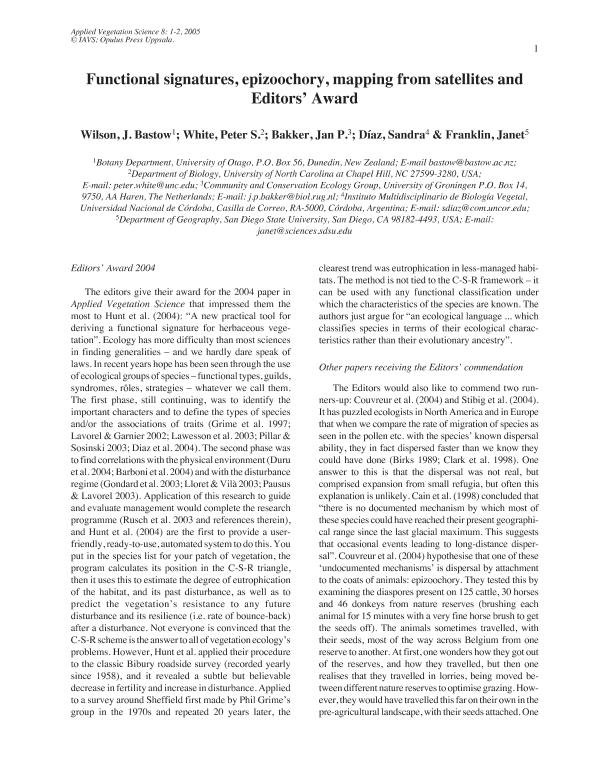Artículo
Editorial article: Functional signatures, epizoochory, mapping from satellites and Editors' Award
Fecha de publicación:
05/2005
Editorial:
Wiley Blackwell Publishing, Inc
Revista:
Applied Vegetation Science
ISSN:
1402-2001
e-ISSN:
1654-109X
Idioma:
Inglés
Tipo de recurso:
Artículo publicado
Clasificación temática:
Resumen
The editors give their award for the 2004 paper in Applied Vegetation Science that impressed them the most to Hunt et al. (2004): “A new practical tool for
deriving a functional signature for herbaceous vegetation”. Ecology has more difficulty than most sciences in finding generalities – and we hardly dare speak of
laws. In recent years hope has been seen through the use of ecological groups of species – functional types, guilds, syndromes, rôles, strategies – whatever we call them. The first phase, still continuing, was to identify the important characters and to define the types of species and/or the associations of traits (Grime et al. 1997;
Lavorel & Garnier 2002; Lawesson et al. 2003; Pillar & Sosinski 2003; Diaz et al. 2004). The second phase was to find correlations with the physical environment (Duruet al. 2004; Barboni et al. 2004) and with the disturbance regime (Gondard et al. 2003; Lloret & Vilà 2003; Pausus & Lavorel 2003). Application of this research to guide and evaluate management would complete the research programme (Rusch et al. 2003 and references therein), and Hunt et al. (2004) are the first to provide a userfriendly, ready-to-use, automated system to do this. You put in the species list for your patch of vegetation, the program calculates its position in the C-S-R triangle,
then it uses this to estimate the degree of eutrophication of the habitat, and its past disturbance, as well as to predict the vegetation’s resistance to any future
disturbance and its resilience (i.e. rate of bounce-back) after a disturbance. Not everyone is convinced that the C-S-R scheme is the answer to all of vegetation ecology’s problems. However, Hunt et al. applied their procedure to the classic Bibury roadside survey (recorded yearly since 1958), and it revealed a subtle but believable decrease in fertility and increase in disturbance. Applied to a survey around Sheffield first made by Phil Grime’s group in the 1970s and repeated 20 years later, the clearest trend was eutrophication in less-managed habitats.
The method is not tied to the C-S-R framework – it can be used with any functional classification under which the characteristics of the species are known. The
authors just argue for “an ecological language ... which classifies species in terms of their ecological characteristics rather than their evolutionary ancestry”.
Palabras clave:
Herbacious Vegetation
,
Plant Traits
,
-
Archivos asociados
Licencia
Identificadores
Colecciones
Articulos(IMBIV)
Articulos de INST.MULTIDISCIPL.DE BIOLOGIA VEGETAL (P)
Articulos de INST.MULTIDISCIPL.DE BIOLOGIA VEGETAL (P)
Citación
Bakker, Jan P.; White, Peter S.; Díaz, Sandra Myrna; Franklin, Janet; Wilson, J. Bastow; Editorial article: Functional signatures, epizoochory, mapping from satellites and Editors' Award; Wiley Blackwell Publishing, Inc; Applied Vegetation Science; 8; 1; 5-2005; 1-2
Compartir
Altmétricas




